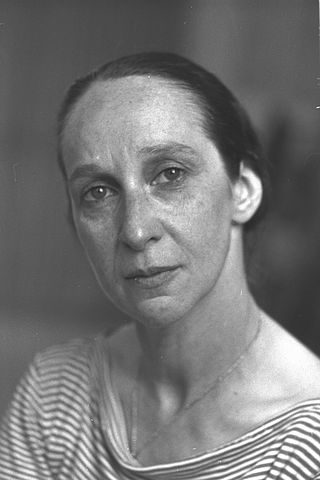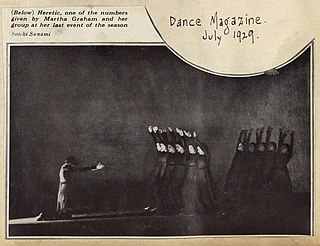Related Research Articles

Martha Graham was an American modern dancer and choreographer. Her style, the Graham technique, reshaped American dance and is still taught worldwide.

Anna Sokolow was an American dancer and choreographer known for the social justice focus and theatricality of her work, and for her support of the development of Modern Dance in Mexico and in Israel.
Appalachian Spring is a musical composition by Aaron Copland that was premiered in 1944 and has achieved widespread and enduring popularity as an orchestral suite. The music, scored for a thirteen-member chamber orchestra, was created upon commission of the choreographer and dancer Martha Graham with funds from the Coolidge Foundation. It was premiered on Monday, October 30, 1944, at the Library of Congress in Washington D.C., with Martha Graham dancing the lead role. The set was designed by the American sculptor Isamu Noguchi. Copland was awarded the 1945 Pulitzer Prize for Music for his achievement.
Terese Capucilli is an American modern dancer, interpreter of the roles originally performed by Martha Graham. She is one of the last generation of dancers to be coached and directed by Graham herself. A principal dancer with the Martha Graham Dance Company for twenty-six years, she became associate artistic director in 1997 and from 2002 to 2005 served as artistic director, with Christine Dakin, seeing the organization and its dancers through the rebirth of the company. A driving force of Graham's work for nearly three decades, she is now Artistic Director Laureate.
Yuriko Kikuchi, known to audiences by her stage name Yuriko, was an American dancer and choreographer who was best known for her work with the Martha Graham Dance Company.

The Martha Graham Dance Company, founded in 1926, is known for being the oldest dance company in the United States. Founded by Martha Graham as a contemporary dance company, it continued to perform pieces, revive classics, and train dancers even after Graham's death in 1991. The company is critically acclaimed in the artistic world and has been recognized as "one of the great dance companies of the world" by the New York Times and as "one of the seven wonders of the artistic universe" by the Washington Post.
Cave of the Heart is a one-act ballet choreographed by Martha Graham to music by Samuel Barber. It was first performed on May 10, 1946, with the title Serpent Heart, at the second annual Festival of Contemporary American Music in the McMillin Theater of Columbia University. Serpent Heart was commissioned by the festival sponsor, The Alice M. Ditson Fund.
Errand into the Maze is a Martha Graham ballet based on a poem by Ben Belitt set to music by Gian Carlo Menotti. The surrealistic set was designed by Isamu Noguchi, the costumes by Graham herself. The dance uses the Greek myth of Ariadne and the Minotaur to explore the theme of conquering one’s inner demons, more specifically the fear of sexual intimacy. The piece premiered at the Ziegfeld Theatre on February 28, 1947, with Graham as the protagonist, a sort of female Theseus, and Mark Ryder as the Minotaur-like character.

Every Soul Is a Circus is a comedic ballet choreographed by Martha Graham. The dance premiered on December 27, 1939, at the St. James Theatre in New York City. The original score was composed by Paul Nordoff. Philip Stapp created the set. Edythe Gilfond designed the costumes. The production marked the first appearance of Merce Cunningham with the Martha Graham Dance Company.
Deaths and Entrances is a ballet choreographed by Martha Graham performed to music by Hunter Johnson. Arch Lauterer created the original set; Edythe Gilfond designed the costumes. The ballet was well-received from the first performance despite being labeled as one of Graham's most personal, least accessible works. Oscar de la Renta created new costumes for the ballet's 2005 revival. The piece premiered on July 18, 1943, at Bennington College in Bennington, Vermont. The first performance was an informal preview for which the dancers wore practice clothes although the set was in place.
American Document is a modern dance work choreographed by Martha Graham in response to rising Fascism in 1930s Europe. The piece premiered on August 6, 1938 at the Vermont State Armory in Bennington, Vermont. The ballet features spoken word excerpts from the Declaration of Independence and Emancipation Proclamation, among other texts. The set was created by Arch Lauterer; the costumes were designed by Edythe Gilfond. The original music was written by Ray Green. Graham extensively reworked the choreography in 1989. John Corigliano's Oboe Concerto replaced Green's music for the revised version.

Heretic is a modern dance work by Martha Graham performed to Tetus Breton, an old folk tune from Brittany. Louis Horst, Graham's musical director, recommended the song, part of the collection Chansons de la Fleur de Lys as arranged by Charles De Sivry. The dance premiered with the title Heretic at New York's Booth Theatre on April 14, 1929. In a previous program announcement, the work was called A Faith. Graham presented the piece with her company; the performance marked the debut of her concert ensemble. Heretic is staged for 13 female performers, 12 dressed in black tube-like garments and one in a long white dress. Dancers for the premiere were: Graham, as the woman in white, Kitty Reese, Louise Creston, Irene Emery, Ethel Rudy, Lillian Ray, Hortense Bunsick, Sylvia Wasserstrom, Mary Rivoire, Ruth White, Lillian Shapero, Virginia Briton, Sylvia Rosenstein, Evelyn Sabin, Betty Macdonald and Rosina Savelli.
El Penitente is a modern dance work by Martha Graham performed to music by Louis Horst. It premiered on August 11, 1940, at the Bennington College Theater, Bennington, Vermont, with costumes by Edythe Gilfond and a set by Arch Lauterer. Isamu Noguchi later redesigned the set and created a new mask.
Dolorosa is a modern dance solo choreographed by Martha Graham to music by Heitor Villa-Lobos. The work premiered on February 2, 1931, at New York's Craig Theatre. Dolorosa sometimes appeared in program notes with the subtitle from Primitive Cycle or from Primitive Cycle-Dance of Sorrow II.
Maple Leaf Rag is a storyless Martha Graham ballet set to ragtime compositions by Scott Joplin. The work premiered on October 2, 1990 at New York City Center with costumes by Calvin Klein and lighting by David Finley. Chris Landriau arranged the music and played piano at the debut. The dance is a jubilant self-parody and an homage, of sorts, to Graham's mentor and musical director, Louis Horst, who would play the rag for her whenever she fell into a creative slump. Graham was 96 when she created Maple Leaf Rag; it is her last completed dance. In 1991, she began another work, The Eyes of the Goddess, but it was unfinished at the time of her death.
Frontier is a solo dance choreographed by Martha Graham to music by Louis Horst. The set was designed by Isamu Noguchi; Graham created the costume. The work began as an ensemble piece, Perspectives: Frontier and Marching Song also known as Frontiers and Frontier. The ballet's Marching Song portion was set to music by Lehman Engle. The work premiered on April 28, 1935, at the Guild Theatre in New York City. By the end of 1935, Graham was performing Frontier exclusively as a solo. The piece was the first of her works to explore American identity through an archetypal character.
Horizons was a modern dance work choreographed by Martha Graham to music by Louis Horst with a set designed by Alexander Calder. It premiered on February 23, 1936, at the Guild Theatre in New York City. Horizons was divided into four parts, two ensemble dances and two solos: Migration: New Trails (ensemble), Dominion: Sanctified Power (solo), Building Motif: Homesteading (solo) and Dance of Rejoycing (ensemble). The ballet was performed by Martha Graham and Group, the predecessor of the Martha Graham Dance Company.
American Lyric was a modern dance work choreographed by Martha Graham to music of Alex North with costumes by Edythe Gilfond. The piece premiered on December 26, 1937, at the Guild Theatre in New York City. The ballet was subtitled Dance of Assembly. In some programs, the work also included the statement, "This dance has as its theme the basic American right—freedom of assembly."
Marie Marchowsky (1916–1977) was an American modern dancer and choreographer who was one of the youngest dancers to train with modern pioneer, Martha Graham.
Yuriko Kimura (木村百合子) is a modern dancer, and was a primary dancer for the Martha Graham Dance Company from 1967 to 1985. Various dance critics, such as Anna Kisselgoff and Clive Barnes from the New York Times, who often reviewed Yuriko's performances, referred to her dancing as "incandescent", and to Kimura as one of the "most outstanding performers in modern dance today" and "a brilliant technician for whom no movement seems impossible". She was born in Kanzawa, Japan.
References
- ↑ Sherwood, M. "Repertory". Martha Graham Dance Company. Retrieved 2022-07-22.
- 1 2 3 4 Deborah Jowitt, Time and the Dancing Image, University of California Press, 1989, p. 182
- ↑ "The Dance". Library of Congress, Washington, D.C. 20540 USA. Retrieved 2022-07-22.
- 1 2 3 Kisselgoff, Anna (1987-10-12). "Ballet: Graham's 'Primitive Mysteries' and 'Judith'". The New York Times. ISSN 0362-4331 . Retrieved 2022-07-22.
- ↑ "Martha Graham Offers A Revival". Library of Congress, Washington, D.C. 20540 USA. Retrieved 2022-07-22.
- ↑ Primitive Mysteries, The Oxford Dictionary of the Dance, Debra Craine and Judith Mackrell, Oxford University Press, 2010, p. 358
- ↑ "Martha Graham Explores Primitive Mysteries". archive.nytimes.com. Retrieved 2022-07-22.
- ↑ Susan Gillis Kruman, Martha Graham (1894-1991), Chapter 3: The Modern Dancers, Introduction to Dance, University of Pittsburgh, Web-based tutorial http://www.pitt.edu/~gillis/dance/martha.html
- ↑ Greskovic, Robert (2004-05-16). "DANCE: THIS WEEK; Martha Graham's One-Name Muse". The New York Times. ISSN 0362-4331 . Retrieved 2022-07-22.
- ↑ Croce, Arlene. Writing in the Dark, Dancing in the New Yorker. Gainesville: University Press of Florida, 2005. Print. p.194-195.
- ↑ "Myth & Mystery in Graham's America". The New York Sun. Retrieved 2022-07-22.
- ↑ Karim Ajania, Terese and Martha Graham, Teaching Dance, The Brick Project http://www.brickproject.com/teaching-dance/